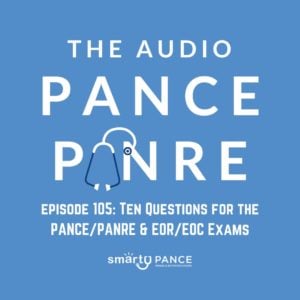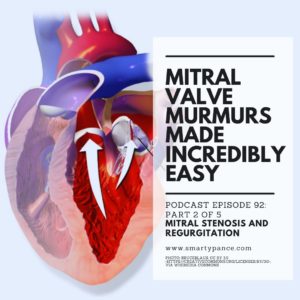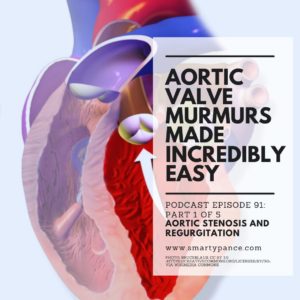Podcast Episode 105: Ten PANCE, PANRE, and Rotation Review Questions
Description
Listen to Podcast Episode 105: Ten PANCE, PANRE, and Rotation Review Questions
If you can’t see the audio player, click here to listen to the full episode.
 Welcome to episode 105 of the Audio PANCE and PANRE Physician Assistant/Associate Board Review Podcast.
Welcome to episode 105 of the Audio PANCE and PANRE Physician Assistant/Associate Board Review Podcast.
Join me today as we cover ten board review questions for your PANCE, PANRE, EOR, and EOC exams.
Links from today’s episode:
- Sign up for the Entire Blueprint Email Series
- Follow Smarty PANCE and The Daily PANCE Blueprint on Instagram
- Follow Smarty PANCE and The Daily PANCE Blueprint on Facebook
- Review systemic lupus erythematosus (SLE)
- Review the diabetes diagnostic guidelines
- Review gestational diabetes screening guidelines
- Review basal cell carcinoma and our comparison tables of the Blueprint dermatologic neoplasms
- Join the Smarty PANCE Member’s Community, then sign up for a study group to get updates about upcoming webinars.
I hope you enjoy this free audio component of the examination portion of this site. Smarty PANCE includes over 2,000 interactive board review questions, along with flashcards, ReelDx cases, integrated Picmonics, and lessons covering every blueprint topic available to all Smarty PANCE members.
- You can download and listen to past FREE episodes here, on iTunes, Spotify, Google Podcasts, Stitcher, Amazon Music, and all podcasting apps
- You can listen to all the latest episodes, take interactive quizzes, and download more resources on each episode page.
Interactive exam to complement today’s podcast
1. A 68-year-old male farmer presents with a flesh-colored papule with a rolled border located on the right side of his forehead. As you examine the lesion closely, you notice something else about the lesion. Which of the following physical exam findings would make you more suspicious of malignancy?
A. Telangiectasia
B. Nikolsky sign
C. Hypopigmentation
D. Tenderness to palpation
E. Central umbilication
The answer is A. Telangiectasia
The patient has basal cell carcinoma, which is a skin cancer with low metastatic potential. It commonly occurs on the face (70% of the time). There are different types of BCC (nodular vs. superficial vs. infiltrative). However, nodular is the most common (80%) and typical characteristics you may see include a papule with a rolled border, pearly-like look, flesh-colored, and telangiectasia. Risk factors for BCC include UV radiation, certain genes, inherited disorders, etc.
Smarty PANCE Content Blueprint Review:
Covered under ⇒ PANCE Blueprint Dermatology ⇒ Dermatologic Neoplasms ⇒ Basal cell carcinoma
Also covered as part of the General Surgery EOR and Family Medicine EOR topic list
2. Which of the following is the most common type of elder abuse?
A. Neglect
B. Emotional abuse
C. Physical abuse
D. Sexual abuse
E. Financial exploitation
The answer is A. Neglect
The most common type of elder abuse is neglect, which refers to the failure of a trusted person to protect an older person from harm or provide for their needs. Self-neglect is also common, which is when an older person can’t proide their own care. Some warning signs include bruising, lacerations, skin tears, spiral fractures, malnutrition, pressure ulcers, and dehydration. If you even suspect an older adult is being neglected, you should report this immediately to adult protective services (or similar agencies) and treat the medical complications immediately.
Smarty PANCE Content Blueprint Review:
Covered under ⇒ PANCE Blueprint Psychiatry ⇒ Abuse and Neglect ⇒ Child/elder abuse
3. Which of the following is the most common bacterial cause of a hordeolum?
A. Streptococcus pyogenes
B. Staphylococcus aureus
C. Clostridium perfringens
D. Propionibacterium species
E. Enterobacter aerogenes
The answer is B. Staphylococcus aureus
A hordeolum (stye) is an abscess of the eyelid that is acute. It will usually present with pain and swelling of the eyelid. The most common pathogen indicated is Staphylococcus aureus. Risk factors include dirty eye makeup, rosacea, and seborrheic dermatitis. A way to differentiate hordeolums from chalazions is that Hordeolums are Hot (aka warm/tender).
Treatment may include warm compresses (10 min up to 5 times daily) plus massaging the eyelid to aid in drainage.
Smarty PANCE Content Blueprint Review:
Covered under ⇒ PANCE Blueprint EENT ⇒ Disorders of the Eye ⇒ Lid disorders ⇒ Hordeolum
Also covered as part of the Family Medicine EOR topic list
4. A 19-year-old female presents to the clinic with fatigue, weight loss, arthralgia, and an erythematous rash in a malar distribution over the cheeks and nose (that spares the nasolabial folds). Which of the following is the most common cardiac manifestation of the patient’s likely diagnosis?
A. Third-degree AV block
B. Mitral regurgitation
C. Myocarditis
D. Pericarditis
E. Bradydysrhythmias
<div







